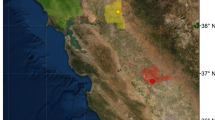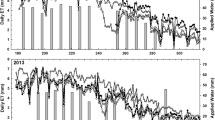Abstract
Vineyards’ canopy architecture and row structure pose unique challenges in modeling the radiation partitioning and energy exchange between the vine canopy and the interrow area. The vines are often pruned and manipulated to be strongly clumped, while mechanical harvesting requires wide rows, often with vine height to vine spacing ratio > 1. This paper estimates the intercepted radiation by the canopy, and the effect of this interception on the below canopy surface energy balance and evapotranspiration (ET). Measurements were conducted in an east–west oriented vineyard in CA during intensive observation periods as part of the grape remote sensing atmospheric profile and evapotrnspiration eXperiment (GRAPEX). Below canopy incoming shortwave radiation was measured at multiple positions across the interrow, and the surface energy balance/ET below the vine rows was measured for only one growing season (in 2015) using three micro-Bowen ratio (MBR) systems. These MBR systems were deployed across the interrow, in the north, center, and south of the interrow. A significant spatial and temporal variability in radiation was observed since the vines were not significantly pruned or manipulated and thus grew randomly into the interrow. However, when averaged across the interrow using the radiation sensor array, the values appeared to give reliable mean radiation extinction conditions that agreed with model estimates. The variation in the surface energy fluxes were dominated by the amount of transmitted radiation, while soil moisture was a second order effect. Daily estimates of ET from the three micro-Bowen ratio systems, weighted by their respective representative sampling area, yielded estimates similar to values computed by the correlation-based flux partitioning method, which utilizes high-frequency eddy covariance data measured above the canopy.











Similar content being viewed by others
Notes
The use of trade, firm, or corporation names in this article is for the information and convenience of the reader. Such use does not constitute official endorsement or approval by the US Department of Agriculture or the Agricultural Research Service of any product or service to the exclusion of others that may be suitable.
References
Aboutalebi M, Torres-Rua A, Kustas WP, Nieto H, Coopsman C, McKee M (2019) Assessment of different methods for shadow detection in high-resolution imagery and elevation of shadows impact on calculation of NDVI, LAI and evapotranspiration. Irrig Sci (this issue)
Agam N, Kustas WP, Alfieri JG, Gao F, McKee LM, Prueger JH, Hipps LE (2019) Grass intercrop and soil water content have a secondary effect on soil heat flux (SHF) in a wine vineyard – implications on SHF measurements. Irrig Sci (this issue)
Alfieri JG, Kustas WP, Prueger JH, McKee LG, Hipps LE, Gao F (2018) A multi-year intercomparison of micrometeorological observations at adjacent vineyards in California’s central valley during GRAPEX. Irrig Sci. https://doi.org/10.1007/s00271-018-0599-3 (this issue, 2019)
Campbell GS, Norman JM (1998) An introduction to environmental biophysics, 2nd edn. Springer, New York
Fuchs M, Stanhill G, Moreshet S (1976) Effect of increasing foliage and soil reflectivity on solar radiation balance of wide-row sorghum. Agron J 68:865–871
Holland S, Heitman JL, Howard A, Sauer TJ, Giese W, Ben-Gal A, Agam N, Kool D, Havlin J (2013) Micro-Bowen ratio system for measuring evapotranspiration in a vineyard interrow. Agric For Meteorol 177:93–100
Kool D, Kustas WP, Ben-Gal A, Lazarovitch N, Heitman J, Sauer TJ, Agam N (2016) Energy and evapotranspiration partitioning in a desert vineyard. Agric For Meteorol 218–219:277–287
Kustas WP, Anderson MC, Alfieri JG, Knipper K, Torres-Rua A, Parry CK, Nieto H, Agam N, White A, Gao F, McKee L, Prueger JH, Hipps LE, Los S, Alsina M, Sanchez L, Sams B, Dokoozlian N, McKee M, Jones S, Wilson TG, Fangni L, McElrone A, Heitman JL, Howard AM, Post K, Melton F, Hain C (2018a) The grape remote sensing atmospheric profile and evapotranspiration experiment (GRAPEX). Bull Am Meteorol Soc 99(9):1791–1812. https://doi.org/10.1175/BAMS-D-16-0244.1
Kustas WP, Alfieri JG, Nieto H, Gao F, Anderson MC, Prueger JH, Wilson TG (2018b) Utility of the two-source energy balance model TSEB in vine and inter-row flux partitioning over the growing season. Irrig Sci. https://doi.org/10.1007/s00271-018-0586-8 (this issue, 2019)
Nijssen B, Lettenmaier DO (1999) A simplified approach for predicting shortwave radiation transfer through boreal forest canopies. J Geophys Res 104(D22):27859–27868
Nieto H, Kustas WP, Torres-Rúa A, Alfieri JG, Gao F, Anderson MC, White WA, Song L, del Mar Alsina M, Prueger JH, McKee M, Elarab M, McKee LG (2018) Evaluation of TSEB turbulent fluxes using different methods for the retrieval of soil and canopy component temperatures from UAV thermal and multispectral imagery. Irrig Sci. https://doi.org/10.1007/s00271-018-0585-9 (this issue, 2019)
Ortega-Farías S, Carrasco M, Olioso A, Acevedo C, Poblete C (2007) Latent heat flux over Cabernet Sauvignon vineyard using the Shuttleworth and Wallace model. Irrig Sci 25:161–170. https://doi.org/10.1007/s00271-006-0047-7
Parry CK, Nieto H, Guillevic P, Agam N, Kustas WP, Alfieri J, McKee L, McElrone AJ (2019) An intercomparison of radiation partitioning models in vineyard row structured canopies. Irrig Sci (this issue)
Reshef N, Walbaum N, Agam N, Fait A (2017) Sunlight modulates fruit metabolic profile and shapes the spatial pattern of compound accumulation within the grape cluster. Front Plant Sci. https://doi.org/10.3389/fpls.2017.00070
Reshef N, Agam N, Fait A (2018) Grape berries acclimate to excess solar irradiance by preferentially accumulating flavonols at the expense of anthocyanins and flavan-3-ols. J Agric Food Chem. https://doi.org/10.1021/acs.jafc.7b04881
Ross J (1981) The radiation regime and architecture of plant stands. Dr W. Junk Publishers, Hague. https://doi.org/10.1007/978-94-009-8647-3
Scanlon TM, Kustas WP (2010) Partitioning carbon dioxide and water vapor fluxes using correlation analysis. Agric For Meteorol 150:89–99
Scanlon TM, Kustas WP (2012) Partitioning evapotranspiration using an eddy covariance-based technique: improved assessment of soil moisture and land-atmosphere exchange dynamics. Vadose Zone J. https://doi.org/10.2136/vzj2012.0025
Scanlon TM, Sahu P (2008) On the correlation structure of water vapor and carbon dioxide in the atmospheric surface layer: a basis for flux partitioning. Water Resour Res 44:W10418. https://doi.org/10.1029/2008WR006932/
Skaggs TH, Anderson RG, Alfieri JG, Scanlon TM, Kustas WP (2018) Fluxpart: open source software for partitioning carbon dioxide and water vapor fluxes. Agric For Meteorol 253–254:218–224
Trambouze W, Bertuzzi P, Voltz M (1998) Comparison of methods for estimating actual evapotranspiration in a row-cropped vineyard. Agric For Meteorol 91:193–208
White AW, Alsina M, Nieto H, McKee L, Gao F, Kustas WP (2019) Indirect measurement of leaf area index in California vineyards: utility for validation of remote sensing-based retrievals. Irrig Sci (this issue)
Acknowledgements
Funding provided by E.&J. Gallo Winery made possible the acquisition and processing of the high-resolution manned aircraft and UAV imagery collected during GRAPEX IOPs. In addition, we would like to thank the staff of Viticulture, Chemistry and Enology Division of E.&J. Gallo Winery for the collection and processing of field data during GRAPEX IOPs. Finally, this project would not have been possible without the cooperation of Mr. Ernie Dosio of Pacific Agri Lands Management, along with the Borden vineyard staff, for logistical support of GRAPEX field and research activities. Finally, the authors would like to acknowledge financial support for this research from NASA Applied Sciences-Water Resources Program (Grant no. NNH17AE39I). USDA is an equal opportunity provider and employer.
Author information
Authors and Affiliations
Corresponding author
Ethics declarations
Conflict of interest
On behalf of all authors, the corresponding author states that there is no conflict of interest.
Additional information
Communicated by S. Ortega-Farias.
Rights and permissions
About this article
Cite this article
Kustas, W.P., Agam, N., Alfieri, J.G. et al. Below canopy radiation divergence in a vineyard: implications on interrow surface energy balance. Irrig Sci 37, 227–237 (2019). https://doi.org/10.1007/s00271-018-0601-0
Received:
Accepted:
Published:
Issue Date:
DOI: https://doi.org/10.1007/s00271-018-0601-0




